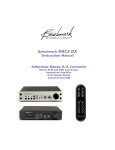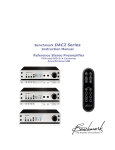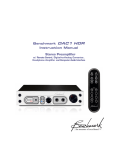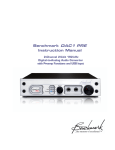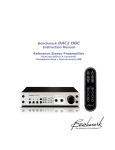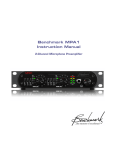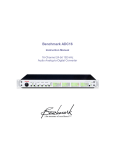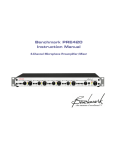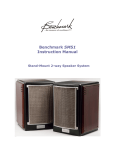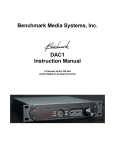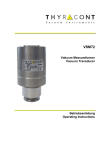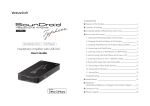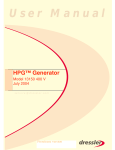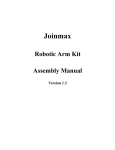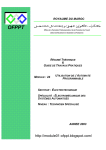Download Benchmark AHB2 Instruction manual
Transcript
Benchmark DAC2 DX Instruction Manual Reference Stereo D/A Converter Native PCM and DSD Conversion Headphone Amplifier Dual Output Buses Asynchronous USB DAC2 DX Instruction Manual Rev A Page 1 Safety Information Fuses CAUTION: FOR CONTINUED FIRE HAZARD PROTECTION ALWAYS REPLACE THE FUSES WITH THE CORRECT SIZE AND TYPE (0.5A 250 V SLO-BLO® 5 X 20 MM – LITTELFUSE® HXP218.500 OR EQUIVALENT). THE FUSE DRAWER INCLUDES TWO FUSES. ALWAYS REPLACE BOTH FUSES AT THE SAME TIME. Voltage Selection THE DAC2 IS EQUIPPED WITH A UNIVERSAL POWER SUPPLY. THERE IS NO VOLTAGE SELECTION SWITCH. AC VOLTAGE RANGE IS 88-264 VAC, 50-60 HZ. THE PRODUCT MAY ALSO BE OPERATED FROM DC POWER OVER A VOLTAGE RANGE OF 125-373 VDC. Power Cord Modifications CAUTION: DO NOT SUBSTITUTE PARTS OR MAKE ANY MODIFICATIONS WITHOUT THE WRITTEN APPROVAL OF BENCHMARK MEDIA SYSTEMS, INC. MODIFICATION MAY CREATE SAFETY HAZARDS AND WILL VOID THE WARRANTY. NOTICE: CHANGES OR MODIFICATIONS NOT EXPRESSLY APPROVED BY BENCHMARK MEDIA SYSTEMS COULD VOID THE USER'S AUTHORITY TO OPERATE THE EQUIPMENT UNDER FCC REGULATIONS. Repairs CAUTION: DO NOT SERVICE OR REPAIR THIS PRODUCT UNLESS PROPERLY QUALIFIED. ONLY A QUALIFIED TECHNICIAN SHOULD PERFORM REPAIRS. CAUTION: ALWAYS USE A GROUNDED POWER CORD. THE PRODUCT IS EQUIPPED WITH A STANDARD IEC POWER ENTRY MODULE. USE AN IEC POWER CORD THAT IS EQUIPPED WITH THE APPROPRIATE CONNECTOR FOR YOUR LOCATION. CORDS ARE AVAILABLE FROM YOUR DEALER. DAC2 DX Instruction Manual Rev A Page 2 Contents Safety Information AC Power-Entry and Fuse Module24 2 Fuses Voltage Selection Power Cord Modifications Repairs 2 2 2 2 2 Quick Start Guide 5 Rear Panel Front Panel Control Functions 5 6 8 Applications Professional Applications HI-FI Applications Computer Sound Card Elimination Standalone Headphone Amplifier DAC2 vs. DAC1 New Features Performance Improvements DAC2 DX Features Feature List Special DAC2 DX Features Feature Details 9 9 9 9 9 10 10 10 11 11 12 13 DAC1 and DAC2 Product History 16 DAC1 Series History DAC2 Series History Digital Inputs Input Formats Limitations of Optical Inputs Consistent Performance USB - Computer Input D1 and D2 - Optical Digital Inputs D3 - AES XLR Digital Input D4 and D5 - Coaxial Digital Inputs D5 - Coaxial Digital Output AES XLR to Coaxial Adapters Analog Outputs Main Output Bus AUX Output Bus Balanced Analog XLR Line Outputs XLR Wiring Unbalanced Analog RCA Line Outputs DAC2 DX Instruction Manual 16 17 18 18 18 18 19 20 20 20 21 21 22 22 22 22 23 23 Fuses Voltage Selection Power Cord 24 24 24 Internal Settings 25 Jumper-Configured Options Removing Top Cover XLR Output Pads Digital Pass-Through Function 25 25 26 30 Rack Mounting Options 31 Universal Rack Adapter Tray ½-Wide Blank Rack Panel - Black ½-Wide Blank Rack Panel - Silver Connector Block 31 31 31 31 Benchmark Technologies 32 Hybrid Gain Control™ Native DSD Conversion Multi-Mode Asynchronous AdvancedUSB Audio™ Jitter-Immune UltraLock2™ High Head-Room DSP 32-bit SABRE Conversion System Diagnostic Display Bi-Directional 12 Volt Trigger Distributed Power Regulation HPA2™ Headphone Amplifier Differential Amplifiers UltraLock2™ Clock System USB Audio System Setup 32 32 32 33 33 33 33 33 33 34 34 34 38 USB Driver Installation - Windows XP, Vista, 7 39 Performance Graphs - DAC2 Series 45 Preliminary Specifications 61 Audio Performance Group Delay (Latency) Digital Audio Inputs Jitter Tolerance Balanced Analog Outputs Unbalanced Analog Outputs HPA2TM Headphone Outputs Status Display AC Power Requirements Dimensions Weight Rev A 61 62 62 63 64 64 65 65 66 66 66 Page 3 Regulatory Compliance FCC and RoHS Compliance Statements FCC Notice (U.S. Only) RoHS Compliant Information CE Certificates of Conformity Warranty Information Benchmark 1 Year Warranty DAC2 DX Instruction Manual 67 67 67 67 68 69 The Benchmark 1 Year Warranty Benchmark Extended Warranty The Benchmark Extended 5* Year Warranty The Benchmark’s Extended 2** Year International Warranty Notes on Warranty Repairs 69 70 70 70 70 69 Rev A Page 4 Quick Start Guide Rear Panel Analog Audio Outputs The DAC2 DX has three stereo analog outputs driven from two separate output busses. By default both busses are controlled from the front panel volume control. Either or both busses may be programmed to BYPASS the volume control. When an output bus is set to BYPASS, the output level is set to a calibrated maximum level. The XLR outputs can deliver +24 dBu. The RCA outputs can deliver 2 Vrms (8.2 dBu). The MAIN output bus drives a pair of balanced XLR outputs and a pair of unbalanced RCA outputs. The AUX output bus drives a pair of unbalanced RCA outputs. Digital Audio Inputs The DAC2 DX has six stereo digital inputs (1 USB, 1 AES XLR, 2 optical and 2 coaxial). The XLR, coaxial and optical inputs accept professional (AES) and consumer (S/PDIF) data formats at word lengths up to 24-bits. The optical inputs are limited to 96 kHz sample rates. All other inputs support sample rates up to 192 kHz. 12V Trigger I/O The 1/8” TRS jack on the rear panel is a bi-directional 12V trigger connection to enable power sequencing between the DAC2 DX and other audio devices in the signal chain. If the tip of the TRS connector is driven to 12 volts, the DAC2 DX will turn on. If the DAC2 DX is turned on locally, the DAC2 DX will drive the tip of the TRS connector to 12 V to turn on other linked devices. AC Power Input The DAC2 DX is equipped with a universal power supply. There is no voltage selection switch. AC voltage range is 88-264 VAC, 50-60 HZ. The fuse drawer contains two fuses, always use exact replacements. DAC2 DX Instruction Manual Rev A Page 5 Front Panel Power Switch Press once to turn on. Press once to turn off. IR Receiver The IR receiver for the remote control is located directly above the power switch. Do not block this opening. MUTE Switch and Light Press to MUTE all outputs. Press again to release. DIM Switch and Light Press to reduce the level of all outputs by 20 dB. Press again to release. Input Selector Switches and Lights Press the INPUT buttons to select a digital input. If an input light is on, the corresponding input is selected and operating normally: U - USB digital audio input D1 - First optical digital audio input D2 - Second optical digital audio input D3 - XLR digital audio input D4 - First coaxial digital audio input D5 - Second coaxial digital audio input If an input light is flashing, the selected input is not connected or is not working properly: Slow Flashes (2 flashes/second) – No input signal, transmission errors, or Non-PCM Rapid flashes – Non-audio (input is flagged as data) Intermittent flashes – Invalid sample (v-bit), unreliable connection DAC2 DX Instruction Manual Rev A Page 6 Output Calibration Lights If a CALIBRATION light is on, the corresponding output bus is set to the calibrated maximum output level and the volume control is bypassed (BYPASS mode). If a CALIBRATION light is flashing slowly, the corresponding output bus is set to BYPASS mode, but the output is muted or dimmed. A - AUX analog output bus is in BYPASS M – MAIN analog output bus is in BYPASS NOTE: If a bus is not in bypass mode, the corresponding CALIBRATION light will flash rapidly when the volume control is adjusted. This feature shows which busses are being adjusted. Word Length Display The DAC2 monitors bit activity to determine the input word length. This gives an accurate indication even when status bits are set incorrectly. 24 – The word length is 24-bits. 16 – The word length is 16-bits. 16 & 24 – The word length is 17 to 23 bits. None - No input, DSD, or word length less than 16 bits. Sample Rate Display The DAC2 measures the incoming sample rate and uses 4 lights to indicate the rate and format. 44.1 – Sample rate is 44.1 kHz 48 – Sample rate is 48 kHz 44.1 & 2X – Sample rate is 88.2 kHz 48 & 2X – Sample rate is 96 kHz 44.1 & 4X – Sample rate is 176.4 kHz 48 & 4X – Sample rate is 192 kHz 2X & 4X – DSD Headphone Jacks The headphone jacks are driven by Benchmark’s “zero-Ohm” HPA2™ headphone power amplifier. Both jacks can be used simultaneously. Both jacks are equipped with switches that can be programmed to mute the MAIN audio output bus when headphones are inserted. By default, the left headphone jack is programmed to mute the MAIN output bus while the right jack will not mute the audio. Internal jumpers can be moved to enable or disable the headphone switches. Other internal jumpers can be moved to adjust the headphone gain range. Volume Control The volume control is a motor-driven rotary potentiometer. The position of the control sets the 32bit digital attenuation. Audio does not pass through the potentiometer. DAC2 DX Instruction Manual Rev A Page 7 Control Functions All DAC2 DX functions can be controlled from the IR remote control or from the front panel. In most cases, operation is identical (see table to the right for a summary of front panel and remote control functions). OFF (remote only) ON (remote only) POWER (front panel only) VOLUME U/D Press once to turn the unit off. * Press and hold to turn off all devices connected to the 12V TRIGGER. Press once to turn the unit on. * If the unit is already on, pressing ON will cancel MUTE and DIM. Press once to turn the unit on or off. * Press and hold POWER to turn off all devices connected via the 12V TRIGGER. Press and hold to turn volume up or down. * VOLUME UP will cancel MUTE. (remote only) DIM Press once to toggle the -20 dB DIM function. *DIM will cancel MUTE. * Press and hold DIM for 10 seconds to toggle the AUX bus VOLUME CONTROL BYPASS function. MUTE Press once to toggle the MUTE function. * Press and hold MUTE for 10 seconds to toggle the MAIN bus VOLUME CONTROL BYPASS function. INPUT Press to change the input. U/D * Press and hold both front panel INPUT buttons while computer is connected to toggle between USB 2.0 and USB 1.1. USB Press to select USB digital input. * Press and hold remote USB button while computer is connected to toggle between USB 2.0 and USB 1.1. D1 Press to select 1st optical input (remote only). D2 Press to select 2nd optical input (remote only). D3 Press to select digital XLR input (remote only). D4 Press to select 1st coaxial input (remote only). D5 Press to select 2st coaxial input if enabled (remote only). ANALOG DAC2 DX Instruction Manual Rev A Not used on DAC2 DX (no analog inputs) Page 8 Applications The DAC2 DX is a professional reference-grade digital to analog converter with two independent analog output busses. It includes Benchmark's reference-quality HPA2™ headphone amplifier, Benchmark's hybrid gain control system, and Benchmark's UltraLock2™ jitter attenuation system. The DAC2 DX is designed to connect directly to power amplifiers and powered monitors. It is also capable of delivering +24 dBu studio interface levels. The DAC2 DX is available with an optional IR remote control which makes it equally well-suited for home applications. In a home Hi-Fi system, the DAC2 DX provides digital source selection, volume control, and direct drive to the power amplifier. The DAC2 DX is the only component required between digital sources and the power amplifier. The DAC2 DX has 6 digital inputs, 2 headphone outputs, a volume control, and 3 sets of analog outputs. It supports D/A conversion of PCM sample rates up to 192 kHz, as well as direct DSD conversion. Professional Applications The DAC2 DX is designed for maximum transparency and purity. The sonic integrity of the DAC2 DX makes it well suited for critical playback in recording studio control rooms and mastering rooms. It includes features that are targeted at the needs of the audio professional. HI-FI Applications The versatility and performance of the DAC2 DX also makes it an asset to any high-end audiophile system. Digital signal sources may include HDTV, DVD, digital cable, music servers, digital radio, portable devices, etc. In a Hi-Fi system, the DAC2 DX replaces the low-performance D/A converters that are built into these low-cost devices. Computer Sound Card Elimination Benchmark’s Multi-Mode Asynchronous USB™ interface makes the DAC2 an ideal output device for computer-based media playback, including: home media servers, digital audio workstations, desktop audio editing applications, and computer-based radio broadcast systems. Standalone Headphone Amplifier The “zero-Ohm” HPA2™ headphone amplifier delivers reference-quality performance. The full performance of the DAC2 is delivered to the headphones. Difficult loads are driven with ease. DAC2 DX Instruction Manual Rev A Page 9 DAC2 vs. DAC1 The DAC2 series builds upon Benchmark’s highly successful DAC1 product family. Every DAC1 subsystem has been redesigned and upgraded to achieve higher performance. The DAC2 includes an updated version of Benchmark's highly-effective UltraLock™ jitter-attenuation system. New Features The DAC2 series introduced new features that add improve the listening experience while extending the versatility of the product. The DAC2 series introduced the following features: Native DSD conversion Asynchronous USB 2.0 Asynchronous USB 1.1 Volume-control bypass Digital pass-through Word-length display Sample-rate display Bi-directional 12V trigger More I/O than DAC1 Series Performance Improvements Lower Noise than the DAC1 An array of balanced 32-bit digital-to-analog audio converters are summed together to form each balanced output channel. The summing reduces noise. The result is that the DAC2 is about 10 dB quieter than the DAC1. Low-level musical details are faithfully reproduced over a breathtakingly quiet noise floor. Lower Distortion than the DAC1 Benchmark’s DAC1 converters are known for their very low distortion (THD and IMD). But, the DAC2 sets new benchmarks for clean and transparent musical reproduction. The DAC2 is designed to provide the cleanest possible path from digital to analog. Lower Power Consumption than the DAC1 The DAC2 complies with the latest international environmental regulations and consumes less than 0.5 W when turned off. The unit runs cool while providing substantial power to the headphone and output drivers. Power can be turned on or off from the front panel, from the remote control, or from the 12V trigger I/O port. DAC2 DX Instruction Manual Rev A Page 10 DAC2 DX Features Feature List HGC™ (Hybrid Gain Control) – combines a motor-driven rotary control and a 32-bit digital attenuator with passive analog attenuators, to achieve state-of-the-art performance SABRE ES9018 - 32-bit PCM D/A conversion system, multiple 32-bit D/A converters per channel SABRE ES9018 – Native DSD D/A conversion system, multiple 1-bit DSD D/A converters per channel HPA2™ reference-grade headphone amplifier - “0-Ohm” high-current high-power outputs Dual Headphone Outputs – jacks can be programmed to mute main output bus HPA2™ gain jumpers - 0 dB, -10 dB, and -20 dB - optimize headphone output levels to match a wide variety of headphone sensitivities Multi-Mode Asynchronous USB Audio 2.0 – 24 bit/192 kHz, DSD (DoP 1.1) Driverless Asynchronous USB Audio 1.1 – 24-bit/96 kHz Benchmark UltraLock2™ Jitter Attenuation System – eliminates jitter-induced distortion Sample Rate Display – 44.1, 48, 88.2, 96, 176.4, 192 kHz and DSD Word Length Display – 16-bit, 24-bit 1 AES XLR Digital Input – 24-bit/192 kHz PCM, DSD (DoP 1.1) 2 Coaxial Digital Inputs – 24-bit/192 kHz PCM, DSD (DoP 1.1) 2 Optical Digital Inputs – 24-bit/96 kHz PCM 1 Coaxial Digital Output – digital pass through from USB, XLR, Coax, and optical inputs Aluminum IR Remote - optional remote provides control of all functions 3 Stereo Analog Outputs – 1 pair, balanced (XLR), plus 2 pairs unbalanced (RCA) 2 Stereo Analog Output Busses – either or both busses can be set to fixed gain Low-Impedance Passive Output Pads – 0, 10, and 20 dB pads – optimize output level to power amplifiers to maximize SNR over a wide variety of interface levels 12V Trigger I/O – bi-directional 12V trigger can act as input, output, or both - links with power amplifier to sequence on/off functions Volume-Control Bypass – places one or both analog output busses in a calibrated fixed-gain mode Mute Function – accessible from remote or front panel, mutes all analog outputs Dim Function – accessible from remote or front panel, reduces level of all outputs by 20 dB Automatic De-Emphasis - responds to consumer pre-emphasis bit (44.1, 48 kHz) Power Switch - accessible from remote or front panel, very low standby power - <0.5 W at 120 VAC High-Efficiency Low-Noise Power Supply – only 12-15 W, 88-264 VAC, 50-60 Hz Meets FCC Class B and CE emissions requirements Tested for immunity to radiated and conducted RF interference DAC2 DX Instruction Manual Rev A Page 11 Special DAC2 DX Features The DAC2 DX has some special features that set the DAC2 DX apart from the rest of the DAC2 product family: AES XLR digital input Dual Analog Output Busses Relay-Muted Analog Outputs These features are tailored to the needs of professional users but some Hi-Fi users may also find them useful. AES XLR Digital Input Many professional users have requested an AES XLR digital input. We have added this to the DAC2 DX without removing any of the other digital outputs. The DAC2 DX has: 1 1 2 2 USB audio input AES XLR input optical inputs coaxial inputs (or 1 input and 1 pass-through) The DAC2 DX does not have analog inputs. Dual Analog Output Busses The MAIN and AUX busses can be programmed to BYPASS the volume control. When set to BYPASS the output is set to a fixed calibrated level. The MAIN and AUX busses are independently programmable for each digital input. This versatility is useful when one input (such as a digital console) has a digital level control while other signal sources do not. The console input could be set to BYPASS while an input from a CD player could be used in VARIABLE mode. The MAIN bus bypass function can be toggled by pressing and holding the MUTE button for 10 seconds. The AUX bus bypass function can be toggled by pressing and holding the DIM button for 10 seconds. This delay is intentionally long so that the function will not be toggled accidentally. The A light will be illuminated when the AUX bus is in BYPASS. The M light will be illuminated when the main bus is in BYPASS. Relay-Muted Analog Outputs The XLR and RCA analog outputs are equipped with mute relays that keep the outputs muted while powering on or off. These relays eliminate pops and clicks at the unit power up or down. DAC2 DX Instruction Manual Rev A Page 12 Feature Details UltraLock2™ Clock System UltraLock2™ provides the outstanding jitter attenuation of the older UltraLock™ system while providing a higher SNR. High-Headroom Digital Processing All digital processing includes at least 3.5 dB headroom above an input level of 0 dBFS. This unique and important feature prevents all clipping in the digital processing, and provides clean, smooth, and transparent audio reproduction. Most competing products lack this important feature. Native DSD Conversion All DAC2 converters support native DSD conversion. DSD signals can be delivered to the USB or Coaxial inputs in DoP 1.1 format. The DSD signal is then routed directly to a bank of 1-bit DSD D/A converters. An array of balanced 1-bit converters are summed together to form each balanced output. Asynchronous USB 2.0 The USB interface supports DSD and 192 kHz, 24-bit PCM. The DAC2 generates the conversion clocks and totally eliminates the USB interface as a source of jitter. No drivers are required for Apple operating systems. Drivers are provided for Windows operating systems at: http://www.benchmarkmedia.com/dac/dac2-drivers Native Asynchronous USB 1.1 The DAC2 has a driverless USB 1.1 mode that supports 96 kHz, 24-bit PCM with most operating systems. This mode provides quick and easy connection to a wide variety of computers and tablets. HGC™ Hybrid Gain Control HGC™ is Benchmark’s unique Hybrid Gain Control that combines 32-bit digital attenuation with passive analog attenuation. The dual-domain HGC™ system combines the accuracy of digital control while preserving dynamic range through the use of passive analog output attenuators. HGC™ outperforms traditional analog or digital volume controls. Musical details are preserved over a very wide range of output levels. Digital inputs are controlled by a 32-bit DSP that feeds a 32-bit signal to the 32-bit conversion system. The output of the conversion system passes through low-impedance passive output attenuators that can be configured to match the output range to the sensitivity of the downstream device. The volume control is a motor-driven analog potentiometer that supplies a DC control signal to the 32-bit DSP system. The volume control rotates in response to commands from the remote control while providing the convenience quick and easy manual adjustments. This topology has the look, DAC2 DX Instruction Manual Rev A Page 13 feel, and convenience of an analog control while providing the accuracy, transparency, and precision of 32-bit digital control. MUTE Function The MUTE function mutes all analog outputs. The MUTE function does not mute the DIGITAL PASS-THROUGH. DIM Function The DIM function fades all analog outputs to a level that is 20 dB lower than normal. This feature is intended to provide a convenient means to fade to and from a temporary background level without changing the volume control setting. DIM should not be used for normal listening. If DIM is required to achieve a normal playback level, this is an indication that the OUTPUT ATTENUATORS are set incorrectly (add more attenuation to fix this problem). Volume-Control Bypass (Calibrated Output Level) The volume control bypass function sets analog outputs to the maximum volume (BYPASS mode). In this mode, the 32-bit digital attenuator is bypassed and a full-level output signal is passed to the analog outputs. This is useful when volume is controlled before or after the DAC2. HPA2™ "Zero-Ohm" Headphone Power Amplifier The HPA2™is one of the most transparent headphone amplifiers available. It also is able to deliver high current and/or high signal levels. This makes it well suited for cleanly driving virtually any set of headphones. The near 0-Ohm output impedance provides outstanding damping of headphone drivers. This damping reduces distortion, and maintains precise control of the frequency response. Headphone Mute Switches The left-hand headphone jack mutes the MAIN analog outputs. In contrast, the right-hand headphone jack allows simultaneous use of the MAIN outputs and headphones. The left-hand jack provides automatic switching between loudspeaker and headphone monitoring. The right-hand jack allows simultaneous use of loudspeakers and headphones. On the DAC2 DX, either or both headphone switches can be enabled or disabled using internal jumpers. The switches and jumpers control logic-level signals, no audio passes through these components. By default, the switch function is enabled on the left-hand jack but disabled on the right-hand jack. The high-power HPA2™ headphone amplifier can easily drive two sets of headphones simultaneously. Both headphones should have similar voltage sensitivities. Direct Interfacing to Power Amplifiers All Benchmark DAC1 and DAC2 converters are designed to directly drive power amplifiers and powered studio monitors. For best performance, no additional devices should be inserted between the DAC and the power amplifier. A direct connection between the DAC and the power amplifier DAC2 DX Instruction Manual Rev A Page 14 always provides the cleanest and shortest path from the digital source to the monitor outputs. This direct connection often produces a substantial improvement in sound quality. The DAC2’s XLR output is equipped with 0, 10 and 20 dB output attenuators for optimal interfacing. The pads optimize the output signal level of the DAC2 to the input sensitivity of virtually any amplifier. Most power amplifiers and powered monitors require the 10 dB or 20 pad setting. Use the 0 dB setting with the Benchmark AHB2 power amplifier. The DAC2 DX output attenuators are factory-set to the 0 dB. Direct Interfacing to +4 dBu Studio Gear If the DAC2 DX will be feeding other professional +4 dBu audio gear, the 0 dB setting should be used. In this setting, the output will reach exactly +24 dBu at 0 dB FS when the volume control is bypassed or to maximum. In other words, the calibration is +4 dBu at -20 dB FS. Digital Pass-Through The second coaxial input (D5) can be reconfigured as a digital output. When operating as an output, any selected digital input is passed through to (D5) without any processing. Optical, coaxial, AES XLR, and USB inputs can be passed through to the (D5) connector. This even includes special digital signals such as DoP, DTS, and Dolby Digital. This feature is particularly useful for connecting digital devices to computers that are not equipped with coaxial digital outputs. The DAC2 can connect to the computer via USB and provide a coaxial digital output to another digital audio device. Bi-directional 12V Trigger The 12V trigger can be connected to other audio components so that an entire audio system can turn on and off in a sequenced fashion. The DAC2 trigger I/O could be connected to a preamplifier, power amplifier, or both. The DAC2 will drive the trigger I/O to 12 volts DC when the DAC2 turns on. If an external device pulls the trigger I/O to 12 volts, the DAC2 will turn on. If an external device pulls the trigger I/O to 0 volts, the DAC2 will turn off. The timing of the trigger system is optimized to minimize any transient pops and clicks during turn-on and turn-off sequences. Low-Noise Power Supplies The DAC2 uses high-efficiency low-noise power supplies. Each critical subsystem has at least one dedicated low-noise regulator. The unit runs cool while providing substantial power to the headphone and output drivers. Power can be turned on or off from the front panel, from the remote control, or from the 12V trigger I/O port. DAC2 DX Instruction Manual Rev A Page 15 DAC1 and DAC2 Product History The pristine audio performance of the award-winning DAC1 made it the ‘Benchmark’ of stand-alone D/A converters. The DAC1 USB and DAC1 PRE, and DAC1 HDR added features and minor performance improvements. DAC1 Series History The classic DAC1 was the first member of the Benchmark DAC1 family. The DAC1 introduced: The 1/2-wide 1-RU form factor UltraLock™ Jitter attenuation Passive output attenuators Analog volume control HPA2™ Headphone amplifier The DAC1 USB added: The first 96 kHz/24-bit USB audio input Headphone switch Headphone gain jumpers High-current LM562/LME49860 output drivers Low-Impedance passive output pads The DAC1 PRE added: A stereo analog input 3 S/PDIF digital inputs LM4562/LME49860 opamps throughout Premium Teflon-insulated bulkhead-mounted RCA connectors The DAC1 HDR added: IR remote-control HDR™ motor-driven volume control MUTE feature DIM feature DAC2 DX Instruction Manual Rev A Page 16 DAC2 Series History The DAC2 series represents a complete redesign of the DAC1. Our goal was to improve every aspect of the DAC1 while adding many of the most requested features. The DAC2 HGC series introduced: HGC™ Hybrid Gain Control 32-bit PCM D/A conversion Native DSD conversion Multi-mode Asynchronous USB Sample rate and word length displays UltraLock2™ jitter attenuation system Volume control bypass Bi-directional 12V trigger More I/O than any member of the DAC1 family Ultra low-noise high-efficiency power supplies Universal power supply Power Switch The DAC2 D was a lower-cost digital-only version of the DAC2 HGC Analog inputs were removed Trigger I/O was removed The DAC2 L is a lower-cost non-headphone version of the DAC2 HGC Headphone amplifier and jacks were removed The DAC2 DX replaces the DAC2 D and shares flagship status with the DAC2 HGC. The DAC2 DX adds these features to the DAC2 D: Dual output busses Output mute relays Dedicated MUTE and DIM buttons AES XLR input Bi-directional 12V trigger DAC2 DX Instruction Manual Rev A Page 17 Digital Inputs There are six stereo digital audio connectors on the DAC2 DX: USB - USB Audio 1.1 or 2.0 Input D1 - TOSLINK Optical Input D2 - TOSLINK Optical Input D3 - XLR Input D4 - Coaxial Input D5 - Coaxial Input or Output Input Formats The optical, XLR, and coaxial inputs can decode AES/EBU or S/PDIF PCM input signals. Professional or consumer data formats are automatically recognized. The USB, XLR and Coaxial inputs can also decode DSD when transmitted in DoP 1.1 format. This format transmits native DSD64 data over conventional digital audio interfaces. The DAC2 will not decode AC3, Dolby, or other compressed formats. The ‘Status Display’ will flash when AC3, Dolby, or other compressed formats are connected to the selected digital input. Limitations of Optical Inputs TOSLINK optical connections are generally limited to sample rates up to 96 kHz. Sample rates above 96 kHz, and DSD inputs may not work through TOSLINK connections. The optical inputs do not accept ADAT format. Consistent Performance The Benchmark UltraLock2™ system removes interface jitter from all digital inputs (including the USB input). The result is that all digital inputs have identical jitter performance. DAC2 DX Instruction Manual Rev A Page 18 USB - Computer Input The USB input supports 44.1, 48, 88.2, 96, 176.4, and 192 kHz sample rates at word lengths up to 24-bits. The USB also accepts DSD. Mac operating systems support all sample rates and formats without drivers. Windows operating systems require drivers for DSD and PCM sample rates above 96 kHz. The USB input accepts a male ‘B-type’ male USB connector. An ‘A-B type’ USB cable is provided with the DAC2. The USB cable connects the DAC2 directly to a standard 'A-type' USB port on the host computer. USB Audio Modes The USB input can be toggled between two different modes: USB AUDIO 1.1 - PCM sample rates up to 96 kHz USB AUDIO 2.0 - PCM sample rates up to 192 kHz, and DSD64 in DoP 1.1 format. USB 1 ports only support the USB Audio 1.1 mode. USB 2 and USB 3 ports support both modes. USB Mode Indication The 2X or 4X lights will flash once when the USB input is selected. This flash indicates the USB mode: The 2X light will flash if the DAC2 is set to USB AUDIO 1.1 mode. The 4X light will flash if the DAC2 is set to USB AUDIO 2.0 mode. Changing the USB Mode The USB MODE can be changed using the front panel or the remote control. To change the USB MODE from the front panel: 1. Select the USB input 2. Press and hold the lower INPUT button for 10 seconds 3. When the mode changes, the 2X or 4X light will flash once to indicate the new mode To change the USB MODE from the remote control: 1. Press and hold the USB button for 10 seconds 2. When the mode changes, the 2X or 4X light will flash once to indicate the new mode USB AUDIO 1.1 MODE (Factory Default) The USB AUDIO 1.1 MODE provides a plug-and-play solution that works with many different operating systems. In most cases, the DAC2 can begin streaming high resolution 24-bit/96 kHz audio bit-transparently within seconds after being plugged into a computer for the first time. Little or no software or hardware configuration is required in this mode. DAC2 DX Instruction Manual Rev A Page 19 The DAC2’s USB AUDIO 1.1 MODE provides driverless operation with Windows XP/Vista/7/8, Mac OS X, and many Linux operating systems. USB AUDIO 2.0 MODE The DAC2’s USB AUDIO 2.0 MODE provides driverless operation with Mac OS X. It is compatible with Windows XP/Vista/7/8 if the Benchmark driver is installed. It has been tested on Mac OS X versions 10.6, 10.7, and 10.8. For the up-to-date information about more recent operating systems and suggestions for optimization, go to: http://benchmarkmedia.com/pages/dac2-drivers D1 and D2 - Optical Digital Inputs The optical input connector is commonly known as a TOSLINK connector. The TOSLINK optical connector used on the DAC2 is designed to work well at sample rates up to 96 kHz. Maximum word length is 24-bits. All sample rates between 28 and 96 kHz are supported. The optical input will accept professional AES/EBU data formats or consumer S/PDIF data formats. The optical inputs do not accept ADAT format. In some cases, TOSLINK connections will operate at sample rates above 96 kHz, but the connection is usually not reliable. Many MAC computers have a TOSLINK optical output hidden in the 1/8" headphone output. A special 1/8" optical connector is required to access this cool feature. Benchmark sells the appropriate cables. D3 - AES XLR Digital Input The AES XLR digital input is transformer isolated. Input impedance is 110 Ohms. Maximum word length is 24 bits. All sample rates between 28 and 195 kHz are supported. The AES XLR input is DC isolated, transformer coupled, current limited, and diode protected. The XLR body and pin 1 are both bonded directly to the chassis to prevent currents in the internal ground system. This direct bonding also maximizes RF shielding. TIP: Shielded 110-Ohm digital audio cable is required for stable performance. Do not use analog XLR cables. D4 and D5 - Coaxial Digital Inputs The coaxial inputs use female RCA connectors that are securely mounted directly to the rear panel. The input impedance is 75 Ohms. Maximum word length is 24-bits. All sample rates between 28 and 195 kHz are supported. DAC2 DX Instruction Manual Rev A Page 20 The Coax inputs are DC isolated, current limited, and diode protected. The RCA body is bonded directly to the chassis to prevent currents in the internal ground system. This direct bonding also maximizes RF shielding. TIP: Shielded 75-Ohm coaxial cable is required for stable performance. Do not use 50Ohm cables or twisted pair cables, or any non-coaxial cables. The Coaxial inputs accept AES/EBU or S/PDIF digital audio formats. AES3-id and SMPTE 276M standards specify 75-Ohm 1 Vpp professional format digital audio signals and these are commonly used in video production facilities. IEC 609588-3 specifies 75-Ohm 0.5 Vpp consumer-format digital audio signals (commonly known as S/PDIF). The coaxial inputs on the DAC2 are designed to accept either type of signal. D5 - Coaxial Digital Output Coaxial connector D5 is a bi-directional port. D5 is factory configured as a digital input. Internal jumpers can be moved to configure D5 as a digital output. When configured as an output, D5 acts as a digital pass-through. Any selected digital input will be routed to D5 without any processing. PASS-THROUGH MODE can be use for: USB to Coax conversion Toslink to Coax conversion AES XLR to Coax conversion Coax to Coax buffering Digital routing Pass-through to slave DAC2 converters AES XLR to Coaxial Adapters Transformers are available to match adapt balanced 110-Ohm AES connections to unbalanced 75Ohm coaxial connections. Our experience is that these work well. Coaxial to XLR adapters should be located near the XLR connector when possible. DAC2 DX Instruction Manual Rev A Page 21 Analog Outputs The DAC2 DX has two independent stereo output busses. By default, both busses are controlled by the front panel volume control. Either or both busses can be set to bypass the volume control. When the volume control is bypassed the volume is set to a calibrated maximum level. The DAC2 DX features high-current output drivers that are capable of driving 300-Ohm loads without an increase in distortion. They are also well suited for driving long cables or highcapacitance loads. All connector pins have their own dedicated drivers. No pins are wired in parallel. Main Output Bus The DAC2 has one pair of balanced XLR outputs and one pair of unbalanced RCA outputs that are driven by the MAIN bus. AUX Output Bus The DAC2 has one pair of unbalanced RCA outputs that are driven by the MAIN bus. Balanced Analog XLR Line Outputs The Left and Right balanced outputs use Neutrik™ gold-pin male XLR jacks. The XLR shell and pin 1 (ground) are both directly bonded to the chassis to prevent currents in the internal ground system. This direct bonding also maximizes RF shielding. The XLR outputs have passive attenuators that allow direct connections to a wide variety of audio devices without a loss of dynamic range. The 10 or 20 dB pads are usually required for direct interfacing to power amplifiers and powered speakers. The DAC2 DX ships with the pads disabled (0-dB setting). A full description of the output attenuators and instructions for configuration is located in the Internal Setting section of this manual. The XLR output level is 24 dBu at maximum volume (or in BYPASS mode) when the output attenuators are set to 0 dB. The XLR output level is 14 dBu at maximum volume (or in BYPASS mode) when the output attenuators are set to -10 dB. The XLR output level is 4 dBu at maximum volume (or in BYPASS mode) when the output attenuators are set to -20 dB. DAC2 DX Instruction Manual Rev A Page 22 XLR Wiring The DAC2 uses industry-standard XLR wiring: XLR pin 2 = + Audio Out XLR pin 3 = - Audio Out XLR pin 1 = Cable Shield CAUTION: If the balanced XLR outputs are wired to an unbalanced input (using a special adapter cable), pin 3 must be left floating. Shorting pin 3 to ground will increase the temperature of the output drivers, will increase power consumption, and may cause distortion. Unbalanced Analog RCA Line Outputs The Left and Right unbalanced outputs use standard RCA style jacks. The ground connections are bonded to chassis ground at the location where analog ground is bonded to the chassis. This minimizes the effects of ground loops caused by AC currents in the cable shield. The XLR output level is 2 Vrms at maximum volume (or in BYPASS mode). This is the same as 8.2 dBu. Note: The XLR pads do not have any effect on the level of the RCA outputs. The RCA output impedance is very low (30 Ohms). This makes these outputs well suited for driving high-capacitance loads and/or high-capacitance cables. TIP: The RCA outputs are capable of driving cables as long as 1360 feet (see Table 1). But, long un-balanced cables will generally suffer from hum problems due to ground loops. We highly recommend using balanced interconnects for long runs. TIP: Mono summing with an RCA ‘Y’ cable is not recommended as this will cause high amounts of distortion. Mono summing with a ‘Y’ cable can be accomplished with the use of a modified cable by implementing a 1k Ohm series resistor in each leg of the ‘Y’. DAC2 DX Instruction Manual Rev A Page 23 AC Power-Entry and Fuses Fuses CAUTION: FOR CONTINUED FIRE HAZARD PROTECTION ALWAYS REPLACE THE FUSES WITH THE CORRECT SIZE AND TYPE (0.5A 250 V SLO-BLO® 5 X 20 MM – LITTELFUSE® HXP218.500 OR EQUIVALENT). THE FUSE DRAWER INCLUDES TWO FUSES. ALWAYS REPLACE BOTH FUSES AT THE SAME TIME. Voltage Selection THE DAC2 IS EQUIPPED WITH A UNIVERSAL POWER SUPPLY. THERE IS NO VOLTAGE SELECTION SWITCH. AC VOLTAGE RANGE IS 88-264 VAC, 50-60 HZ. THE PRODUCT MAY ALSO BE OPERATED FROM DC POWER OVER A VOLTAGE RANGE OF 125-373 VDC. Power Cord The AC power input uses a standard IEC type connector. One USA-compatible power cord is included with DAC2 converters. IEC style power cords in country-specific configurations are available in your locality. CAUTION: ALWAYS USE A GROUNDED POWER CORD. THE PRODUCT IS EQUIPPED WITH A STANDARD IEC POWER ENTRY MODULE. USE AN IEC POWER CORD THAT IS EQUIPPED WITH THE APPROPRIATE CONNECTOR FOR YOUR LOCATION. CORDS ARE AVAILABLE FROM YOUR DEALER. DAC2 DX Instruction Manual Rev A Page 24 Internal Settings Jumper-Configured Options The following functions are jumper configured: XLR Output Pads Headphone Switches Headphone Gain Digital Pass-Through Removing Top Cover The DAC2 top cover must be removed to gain access to the jumpers. Do not attempt to remove the faceplate or the rear panel. CAUTION: The DAC2 contains static sensitive components. Static discharge may cause component failures, may affect the long-term reliability, or may degrade the audio performance. Use a static control wrist strap when changing jumper settings. Disconnect AC power by unplugging the power cord at the back of the DAC2 DX. Remove only the 8 screws holding the cover (4 on each side). Do not remove any screws on front or rear panels! Never remove the power entry safety cover in the rear corner of the DAC2 DX. Always connect a static-control wrist strap to the chassis before touching any internal component. DAC2 DX Instruction Manual Rev A Page 25 XLR Output Pads The XLR outputs are equipped with low-impedance passive pads that may be used to reduce the output levels while preserving the full dynamic range of the DAC2 DX. The unit ships with the pads disabled (0 dB setting). When the output pads are enabled, the output impedance changes slightly, and the maximum allowable cable length should be reduced as shown in Table 1 (assuming 32 pF/foot and a maximum allowable loss of 0.1 dB at 20 kHz). Balanced Output Drive Capability: Attenuator Output Maximum Loss in dB Setting (dB) Impedance Cable (ft) at 20 kHz 0 60 680 0.1 10 425 96 0.1 20 135 302 0.1 Unbalanced Output Drive Capability: Output Maximum Loss in dB Impedance Cable (ft) at 20 kHz 30 1360 0.1 TIP: To set the XLR outputs to typical professional studio levels, set the pads to 0 dB. For most home installations, set the pads to 10 dB or 20 dB. Use the 0 dB setting when driving the Benchmark AHB2 power amplifier. TIP: When directly driving power amplifiers and powered speakers, start with the 10 dB pad setting. If necessary, change the pads so that normal listening levels are achieved with the ‘Volume Control’ above the 11 o’clock position. Use the 0 dB setting with Benchmark's AHB2 power amplifier. Table 1 - Cable Drive Capability XLR Output Pad Selection (P8, P9, P10, and 11): Four 6-pin headers (P8, P9, P10, and P11) allow selection of the analog output level at the XLR jacks. One pair of 6-pin headers controls the output level at each XLR jack as follows: 0 dB Attenuation = +24 dBu at full output -10 dB Attenuation = +14 dBu at full output -20 dB Attenuation = +4 dBu at full output Figure 1 - 0 dB Pad Setting (Factory Default) 0 dB - Jumper plug between pins 1 and 2 of each header – Factory Default -10 dB – Jumper plug between pins 3 and 4 of each header -20 dB – Jumper plug between pins 5 and 6 of each header DAC2 DX Instruction Manual Rev A Page 26 Headphone Switch Configuration: The DAC2 is configured so that the MAIN analog outputs will mute when a headphone plug is inserted into the left-hand jack. This is convenient when the user wishes to switch between headphones and speakers. This feature can be changed or defeated by moving jumpers at P1 on the back of the front panel. Either headphone switch can be enable or disabled by moving the jumpers. Connect the bottom two pins with a jumper to enable the mute switch for the left-hand jack Factory Default (see Figure 2). Connect the top two pins with a jumper to enable the mute switch for the right-hand jack. Add a second jumper if necessary. No Jumpers - Both switched disabled Top Jumper Only - Right-hand switch enabled Bottom Jumper Only - Left-hand switch enabled - Factory Default Top and Bottom Jumpers - Both switches enabled Jumper(s) rotated vertically - Storage of unused jumper(s) Unused jumper(s) may be stored vertically on either pair of pins. Figure 2 - Left Headphone Switch Enabled (Factory Default) DAC2 DX Instruction Manual Rev A Page 27 Headphone Attenuation Jumpers (JP3 and JP4): The gain range of the HPA2™ can be set using jumpers JP3 and JP4: 0 dB attenuation - see Figure 3 10 dB attenuation - see Figure 4 (Factory Default) 20 dB attenuation - see Figure 5 The attenuation is inserted before the HPA2™ headphone amplifier. This attenuator location keeps the output impedance of the HPA2™ constant and very near 0 Ohms. External attenuators should never be inserted after a headphone amplifier as this would change the output impedance. Proper attenuator settings are important for maximizing the SNR of the headphone monitoring system. With proper settings, the full performance of the DAC2 can be delivered to the headphones for critical monitoring tasks, or maximum musical enjoyment. When the headphone attenuation jumpers are set properly, a normal listening level will be achieved between the 10 o'clock and 2 o'clock volume-control positions. If a normal listening level is achieved below a 10 o’clock volume-control position, the headphone gain is too high, and the attenuation should be increased. If the level is too low at a 2 o-clock volume-control position, the headphone gain is too low, and the attenuation should be decreased. Figure 3 - 0 dB Headphone Attenuation DAC2 DX Instruction Manual Rev A Page 28 Figure 4 - 10 dB Headphone Attenuation - (Factory default) Figure 5 - 20 dB Headphone Attenuation DAC2 DX Instruction Manual Rev A Page 29 Digital Pass-Through Function Coaxial connector D5 is factory configured as an input. This connector can be reconfigured as a digital output by moving both P14 jumpers toward the faceplate. When re-configured as an output, the raw data from any selected digital input is buffered passed out through D5. The Digital Pass-Through is bit-transparent. No data is modified. MUTE, DIM, and VOLUME control functions do not change the data in any way. The Digital Pass-Through function can be used for the following purposes: USB to Coaxial Transfers Optical to Coaxial Transfers AES XLR to Coaxial Transfers Coaxial to Coaxial Buffering Slaving another DAC2 When the Digital Pass-Through function is enabled, D5 cannot be selected as an input. If D5 can be selected, the Digital Pass-Through function is disabled. Figure 7 shows the factory default position (Digital Pass-Through function disabled, D5 is an input). Figure 7 – Digital Pass Through - Disabled (Factory Default) DAC2 DX Instruction Manual Rev A Page 30 Rack Mounting Options Call us, visit our website (http://www.BenchmarkMedia.com), or contact your dealer to purchase accessories for your DAC2. Universal Rack Adapter Tray The Universal Rack Adapter Tray is a tray that mounts up to two ½-wide Benchmark products in a standard 19 inch wide 1-RU rack space. The tray accepts any combination of ½-wide Benchmark products (with or without rack-mount type faceplates). ½-Wide Blank Rack Panel - Black The Blank Rack Panel is a ½-wide 1-RU black-anodized aluminum panel for covering an unused slot in the Universal Rack Adapter Tray. It can also be used with a connector block and a DAC2 DX with a rack-mount type faceplate. ½-Wide Blank Rack Panel - Silver This premium blank panel includes an engraved Benchmark logo, and matches the finish on the silver rack-mount version of the DAC2 DX. Connector Block The connector block joins two ½-wide Benchmark products with rack-mount type faceplates. The joined units fill a standard 19 inch wide 1-RU rack space. The connector block can also join a single ½-wide Benchmark product to a Benchmark ½-wide blank panel. DAC2 DX Instruction Manual Rev A Page 31 Benchmark Technologies Hybrid Gain Control™ "HGC" is Benchmark's unique Hybrid Gain Control™ system. The DAC2 combines active analog gain control, passive lowimpedance attenuators, a 32-bit digital gain control, and a servo-driven volume control. All inputs are controlled by the rotary volume control. This volume control moves in response to commands from the remote control. Analog inputs are never converted to digital, and digital inputs never pass through an analog potentiometer. Digital inputs are precisely controlled in the 32-bit DSP system. The DSP system preserves precise L/R balance, and precise stereo imaging, while avoiding any source of noise and distortion. Benchmark's unique passive output attenuators provide distortion-free gain reduction without reducing the dynamic range of the converter. The attenuators optimize the gain staging between the DAC2 and the power amplifier. This optimization is absolutely essential for maximizing the dynamic range of the entire playback system. Much of the success of the DAC1 converters can be attributed to the passive output attenuators. Musical details can be obscured by system noise whenever a preamplifier and power amplifier are improperly matched. The "HGC" system will make full use of your power amplifier's dynamic range. Experience the new details in your favorite recordings. Native DSD Conversion The digital coaxial, XLR, and USB 2.0 inputs on the DAC2 DX support native DSD conversion. DoP 1.1 is automatically detected on all digital inputs, and the system seamlessly switches to native DSD conversion. DoP 1.1 is supported by many media players, and DSD downloads are now available from several sources. DAC2 DX Instruction Manual Visit our website for an up-to-date list of DSD and PCM high resolution download sites. Multi-Mode Asynchronous AdvancedUSB Audio™ Benchmark's USB system supports USB Audio 2.0, DSD, and USB Audio 1.1. It is frequency agile, and will follow sample rate changes initiated by the computer and/or the media playback software. In all modes the USB communications are asynchronous in order to eliminate unnecessary sources of jitter. The DAC2 has a low-jitter master clock which controls the transfer of audio data from the computer to the USB sub-system. The computer asynchronously transfers audio data to a buffer in the DAC2. The contents of the buffer are then asynchronously transferred to the D/A conversion sub-system. This second asynchronous transfer eliminates any traces of jitter that accumulate as the data is transferred between the USB and conversion subsystems. No traces of jitter-induced distortion are measurable to our measurement limits (better than -160 dBFS). This truly represents the state-of-the art. Enjoy the convenience of computer playback without compromise. The Asynchronous USB system supports USB Audio 2.0 for high-resolution 192kHz, and DSD playback. No drivers are required for MAC operating systems. An easy-to-install driver adds 192 kHz and DSD capabilities to Windows operating systems. You can download the latest drivers from: http://www.benchmarkmedia.com/dac/dac2drivers An asynchronous driverless USB Audio 1.1 mode supports sample rates up to 96 kHz. This USB mode can be selected from the front panel or from the remote control. The driverless USB Audio 1.1 mode allows quick plug-and-play connections to Windows, MAC, iOS, and Linux operating systems without installing drivers. Just plug in the USB, and the DAC2 becomes an available audio device. Rev A Page 32 The USB sub-system remains active when the DAC2 is powered down. This prevents interruptions to the computer playback operations and eliminates the need to reconfigure the computer every time the converter is turned on. Jitter-Immune UltraLock2™ UltraLock2™ is an improved version of the UltraLock™ system used in the DAC1 product family. DSP processing is 32-bits, DSP headroom is 3.5 dB, sample rate is 211 kHz, and jitter-induced distortion and noise is at least 160 dB below the level of the music well below the threshold of hearing. Benchmark's UltraLock2™ system eliminates all audible jitter artifacts. High Head-Room DSP All of the digital processing in the DAC2 is designed to handle signals as high as +3.5 dBFS. Most digital systems clip signals that exceed 0 dBFS. The 0 dBFS limitation seems reasonable, as 0 dBFS is the highest sinusoidal signal level that can be represented in a digital system. However, a detailed investigation of the mathematics of PCM digital systems will reveal that inter-sample peaks may reach levels slightly higher than +3 dBFS while individual samples never exceed 0 dBFS. These inter-sample peaks are common in commercial releases, and are of no consequence in a PCM system until they reach an interpolation process. But, for a variety of reasons, virtually all audio D/A converters use an interpolation process. The interpolation process is absolutely necessary to achieve 24-bit state-of-the art conversion performance. Unfortunately, inter-sample overs cause clipping in most interpolators. This clipping produces distortion products that are non-harmonic and non-musical. We believe these broadband distortion products often add a harshness or false high-frequency sparkle to digital reproduction. The DAC2 avoids these problems by maintaining at least 3.5 dB of headroom in the entire conversion system. We believe this added headroom is a groundbreaking improvement. DAC2 DX Instruction Manual 32-bit SABRE Conversion System Four balanced 32-bit D/A converters deliver audio to Benchmark's low-impedance current to voltage converters. The MAIN bus uses 3:1 redundancy to reduce noise and distortion to insignificant levels. The conversion system at the core of the DAC2 is as good as it gets. The analog circuits that follow the D/A converter are carefully designed. Benchmark has leveraged its long history of building reference analog audio equipment to create an outstanding output stage. Diagnostic Display Ever wonder why that 192 kHz 24-bit download on your computer just doesn't sound right? Your media player may be down-sampling to 44.1 kHz and/or truncating to 16-bits. Many media players apply poorquality sample rate conversion and truncation. Fortunately these problems can be eliminated with the selection of a good frequency-agile media player. The samplerate and word-length displays on the DAC2 confirm the proper operation of your media player. Bi-Directional 12 Volt Trigger Benchmark re-invents the 12 volt trigger. The trigger connection on the DAC2 can be used as an input or output or both, and is compatible with any common 12 volt trigger input or output. The trigger can be used to turn a power amplifier on or off automatically. The DAC2 will also respond to a 12 volt trigger and follow the actions of another audio component. Distributed Power Regulation To achieve the lowest possible noise, the DAC2 uses distributed power supply regulation. Each critical sub-system has at least one dedicated low-noise voltage regulator. Rev A Page 33 HPA2™ Headphone Amplifier The DAC2 headphone output is driven by Benchmark’s signature HPA2™ headphone amplifier. This high-current, high-output amplifier has an output impedance of near 0Ohms. It is designed to drive loads as low as 30 Ohms without any increase in distortion. It also has sufficient amplitude to drive lowsensitivity 600-Ohm headphones. The HPA2™ includes current-limiting circuits that fully protect against damage from short circuits. This is important because the right channel of a headphone amplifier will experience a short whenever a mono phone plug is inserted into the stereo headphone jack. Shorts may also occur when a plug is partially inserted. '0-Ohm' Output Impedance Most headphone amplifiers use series resistors to maintain stability and protect against short-circuit conditions. These resistors are usually at least 30 Ohms, and have a negative impact on performance. A headphone amplifier with series resistors may measure very well when driving resistive loads. However, the same amplifier will measure very poorly when driving a headphone load. Unfortunately, most manufacturers do not specify headphone amplifier performance with anything other than ideal resistive loads. Our measurements show that headphones do not behave like resistive loads. Headphone Performance In our tests we have measured substantial distortion across resistors that are wired in series with headphones. We conducted measurements with a variety of headphones. In general, distortion increases as headphone impedance decreases. This distortion can be eliminated with a properly designed 0-Ohm headphone amplifier. The performance of the HPA2™ does not change when headphones are driven. THD+N measurements for no-load, 30-Ohm resistive DAC2 DX Instruction Manual loads, 30-Ohm headphone loads, and 600Ohm headphone loads are virtually identical. The HPA2™ will substantially improve the sound of 30 and 60-Ohm headphones. It will make very noticeable improvements with 600-Ohm headphones. Differential Amplifiers Differential amplifiers remove common-mode distortion components from the D/A converter outputs. This feature is critical for achieving low-distortion in down-stream devices. Benchmark addresses common-mode distortion so that it will not cause distortion in power amplifiers and other connected devices. Common-mode distortion can cause audible distortion while escaping the scrutiny of an audio analyzer. The balanced and unbalanced outputs on the DAC2 deliver very similar performance. Many D/A converters omit the differential amplifiers after the converters. Specifications usually ignore common-mode distortion. A balanced signal with high common-mode distortion can measure just fine when feeding a precisely balanced input on a high-quality audio analyzer. However, any imbalance in a downstream device will expose the common-mode distortion. UltraLock2™ Clock System Accurate 24-bit audio conversion requires a very low-jitter conversion clock. Jitter can very easily turn a 24-bit converter into a 16bit converter (or worse). There is no point in buying a 24-bit converter if clock jitter has not been adequately addressed. Jitter is present on every digital audio interface. This type of jitter is known as ‘interface jitter’ and it is present even in the most carefully designed audio systems. Interface jitter accumulates as digital signals travel down a cable and from one digital device to the next. If we measure interface jitter in a typical system we will find that it is 10 to 10,000 times higher than the maximum allowable level for accurate 24-bit conversion. Rev A Page 34 Fortunately, interface jitter has absolutely no effect on the audio unless it influences the conversion clock in an analog-to-digital converter (A/D) or in a digital-to-analog converter (D/A). Many converters use a single-stage Phase Lock Loop (PLL) circuit to derive their conversion clocks from AES/EBU, Wordclock, or Superclock reference signals. Single-stage PLL circuits provide some jitter attenuation above 5 kHz but none below 5 kHz. Unfortunately, digital audio signals often have their strongest jitter components at 2 kHz. Consequently, these converters can achieve their rated performance only when driven from very low jitter sources and through very short cables. It is highly unlikely that any converter with a single-stage PLL can achieve better than 16 bits of performance in a typical installation. Specified performance may be severely degraded in most installations. Better converters usually use a two-stage PLL circuit to filter out more of the interface jitter. In theory, a two-stage PLL can remove enough of the jitter to achieve accurate 24-bit conversion (and some do). However, not all two-stage PLL circuits are created equal. Many two-stage PLLs do not remove enough of the low-frequency jitter. In addition, twostage PLL circuits often require several seconds to lock to an incoming signal. Finally, a two-stage PLL may fail to lock when jitter is too high, or when the reference sample frequency has drifted. UltraLock™ converters exceed the jitter performance of two-stage PLL converters, and are free from the slow-lock and no-lock problems that can plague two-stage PLL designs. UltraLock™ converters have extremely high immunity to interface jitter under all operating conditions. No jitterinduced artifacts can be detected using an Audio Precision System 2 Cascade test set. Measurement limits include detection of artifacts as low as –160 dBFS, while applying jitter amplitudes as high as 12.75 UI, over a frequency range of 2 Hz to 200 kHz. Any AES/EBU signal that can be decoded by the DAC2 DX Instruction Manual AES/EBU receiver will be reproduced without the addition of any measurable jitter artifacts. The DAC2 employs Benchmark’s UltraLock2™ technology to eliminate jitterinduced performance problems. UltraLock2™ technology isolates the conversion clock from the digital audio interface clock. Jitter on a D/A digital audio input, or an A/D reference input can never have any measurable effect on the conversion clock of an UltraLock2™ converter. In an UltraLock2™ converter, the conversion clock is never phase-locked to a reference clock. Instead the converter oversampling-ratio is varied with extremely high precision to achieve the proper phase relationship to the reference clock. The clock isolation of the UltraLock2™ system ensures that interface jitter can never degrade the quality of the audio conversion. Specified performance is consistent and repeatable in any installation with cables of any quality level! How does conversion clock jitter degrade converter performance? Problem #1: Jitter phase-modulates the audio signal. This modulation creates sidebands (unwanted tones) above and below every tone in the audio signal. Worse yet, these sidebands are often widely separated from the tones in the original signal. Jitter-induced sidebands are not musical in nature because they are not harmonically related to the original audio. Furthermore, these sidebands are poorly masked (easy to hear) because they can be widely separated above and below the frequencies of the original audio tones. In many ways, jitter induced distortion resembles intermodulation distortion (IMD). Like IMD, jitter induced distortion is much more audible than harmonic distortion, and more audible than THD measurements would suggest. Jitter creates ‘new audio’ that is not harmonically related to the original audio signal. This ‘new audio’ is unexpected and unwanted. It can cause a loss of imaging, and Rev A Page 35 can add a low and mid frequency ‘muddiness’ that was not in the original audio. Put UltraLock™ converters to the test: Jitter induced sidebands can be measured using an FFT analyzer. We encourage our customers to perform the above tests on UltraLock2™ converters (or let your ears be the judge). There will be absolutely no change in performance as jitter is added to any digital input on an UltraLock2™ converter. Try the same tests on any converter using conventional single or two-stage PLL circuits. Tests should be performed with varying levels of jitter and with varying jitter frequencies. The results will be very enlightening. Jitter related problems have audible (and measurable) effects on A/D and D/A devices. Practitioners of Digital Audio need to understand these effects. Problem #2: Jitter can severely degrade the anti-alias filters in an oversampling converter. This is a little known but easily measurable effect. Most audio converters operate at high oversampling ratios. This allows the use of high-performance digital anti-alias filters in place of the relatively poor performing analog anti-alias filters. In theory, digital anti-alias filters can have extremely sharp cutoff characteristics, and very few negative effects on the in-band audio signal. Digital anti-alias filters are usually designed to achieve at least 100 dB of stop-band attenuation. But, digital filters are designed using the mathematical assumption that the time interval between samples is a constant. Unfortunately, sample clock jitter in an A/D or D/A varies the effective time interval between samples. This variation alters the performance of these carefully designed filters. Small amounts of jitter can severely degrade stop-band performance, and can render these filters useless for preventing aliasing. The obvious function of a digital anti-alias filter is the removal of audio tones that are too high in frequency to be represented at the selected sample rate. The not-so-obvious function is the removal of high-frequency signals that originate inside the converter box, or even originate inside the converter IC. These high-frequency signals are a result of crosstalk between digital and analog signals, and may have high amplitudes in a poorly designed system. Under ideal (low jitter) conditions, a digital anti-alias filter may remove most of this unwanted noise before it can alias down into lower (audio) frequencies. These crosstalk problems may not become obvious until jitter is present. Stop-band attenuation can be measured very easily by sweeping a test tone between 24 kHz and at least 200 kHz while monitoring the output of the converter. DAC2 DX Instruction Manual Is it possible to eliminate all of the effects of jitter in an entire digital audio system? Interface jitter will accumulate throughout even the most carefully designed digital audio system. Fortunately, interface jitter can only degrade digital audio if it affects the sampling circuit in an analog-to-digital or digital-to-analog converter. Any attempt to cure jitter outside of an A/D or D/A will prove expensive and, at best, will only partially reduce jitter-induced artifacts. Dedicated clock signals (word clock, and super clock, etc.) are often distributed to A/D converters and D/A converters in an attempt to reduce jitter. Again, these are only partial solutions because jitter even accumulates in these clock distribution systems. Furthermore, a poor quality master clock generator can degrade the performance of the entire system (if converter performance is dependent upon reference clock quality). Jitter free A/D and D/A converters are the only true ensurance against the ill effects of jitter. UltraLock2™ converters are jitter-immune under all operating conditions (they will never add audible jitter induced artifacts to an audio signal). Rev A Page 36 What UltraLock™ converters cannot do: UltraLock2™ converters cannot undo damage that has already been done. If an A/D with a jitter problem was used to create a digital audio signal, then there is nothing that can be done to remove the damage. Jitterinduced sidebands are extremely complex and cannot be removed with any existing audio DAC2 DX Instruction Manual device. Therefore, it is very important to attack jitter at both ends of the audio chain. The DAC2 is a great start, as it will allow accurate assessment of various A/D converters. It is impossible to audibly evaluate A/D performance without a good D/A. The consistent performance delivered by the DAC2 eliminates one major variable: jitter. Rev A Page 37 USB Audio System Setup Plug it in and Start Listening… Immediately Benchmark's Advanced USB Audio technology is truly 'Plug and Play'. When connecting to a USB port on a computer running Windows or Mac OSX, the computer will automatically and instantaneously recognize the presence of the Benchmark USB device in USB 1.1, playing tracks up to 96 kHz 24-bit. Any audio played from the computer will then be routed to the Benchmark USB device immediately. There is no software to install or configure. To play tracks up to 192 kHz or DSD, the DAC2 needs to be engaged in USB 2.0 mode. To engage it in USB 2.0 mode, hold down the USB button on the remote control until you see the 4X LED blink. If the 2X LED blinks instead of the 4X LED, hold down the USB button again on the remote control until you see the 4X LED blink. In Mac OS X, no driver is required to play tracks up to 192 kHz or DSD. On Windows XP, Vista, or 7, a driver is required for 192 kHz or DSD playback. To download the driver and get the instructions for Windows XP, Vista, 7, and 8, please visit: http://www.benchmarkmedia.com/dac/dac2-drivers DAC2 DX Instruction Manual Rev A Page 38 USB Driver Installation - Windows XP, Vista, 7 Note: The DAC2 driver is available for download at: http://www.benchmarkmedia.com/dac/dac2hgc/driver Before you install the driver, make sure the USB is unplugged before installation of the driver. 1. In the DAC2 Driver folder, double click “setup.exe.” DAC2 DX Instruction Manual Rev A Page 39 2. A welcome screen will pop-up. Click “Next.” DAC2 DX Instruction Manual Rev A Page 40 3. When you see the following screen, turn on the DAC2, and select USB as your input. By default, the DAC2 is shipped in USB 1.0 mode. You can enable your DAC2 in USB 2.0 mode in two ways. 1) Using your remote control, hold down the USB button on your remote control for 3-4 seconds until you see the 4X LED light up for 3-4 seconds. 2) From the front faceplate, hold down both input buttons until you see the 4X LED light up for 3-4 seconds. 4. You will be prompted to select a location to install the driver in. It will default to your Program Files folder. If you wish to install it another location, you can change the location. We suggest keeping it in the default destination folder. DAC2 DX Instruction Manual Rev A Page 41 Press “Install” DAC2 DX Instruction Manual Rev A Page 42 5. When the installation begins you will see the following screen. Please be patient while the driver installs. Installation time is between 1-5 minutes. 6. Once the installation finishes a message at the top will say “Installation Complete.” Press “Next” to continue. DAC2 DX Instruction Manual Rev A Page 43 7. Click “Finish.” The Setup will close automatically and this completes the installation process. You can now enjoy music up to 192 kHz and DSD. DAC2 DX Instruction Manual Rev A Page 44 Performance Graphs - DAC2 Series The following graphs were produced using a DAC2 HGC. The DAC2 DX provides similar performance. Audio Precision FFT Idle Channel Noise, 0 dBr = 0 dBFS = 23 dBu +0 +0 -20 -20 -40 -40 -60 -60 d B r -80 -80 d B r A -100 -100 A -120 -120 -140 -140 -160 -160 0 2k 4k 6k 8k 10k 12k 14k 16k 18k 20k 22k 24k 26k 28k 30k 32k Hz Sweep Trace Color Line Style Thick Data Axis 1 1 1 2 Green Red Solid Solid 4 4 Fft.Ch.1 Ampl Fft.Ch.2 Ampl Left Right Comment DAC2 - FFT Idle Channel Noise.at27 Graph Plot 1 – FFT Idle Channel Noise The extraordinary performance of the DAC2 is demonstrated by the FFT plot shown above. There is no sign of any AC hum, there are no idle tones, and there are no spurious tones detected at a measurement limit of -160 dBFS. The rise at 0 Hz is normal in an FFT analysis and is not an indication of noise. This 32k point FFT analysis uses a Blackman-Harris window with 16x power averaging, and spans a frequency range of DC to 32 kHz. DAC2 DX Instruction Manual Rev A Page 45 Audio Precision FFT Idle Channel Noise - Low Frequency, 0 dBr = 0 dBFS = 23 dBu dx=120.470 Hz +0 dy=-1.126 dB +0 -20 -20 -40 -40 -60 -60 d B r -80 -80 d B r A -100 -100 A -120 -120 -140 -140 -156.413 -157.539 -160 -160 60.1566 75 50 25 100 125 150 180.626 175 200 225 250 275 300 325 350 375 400 Hz Sweep Trace Color Line Style Thick Data Axis 1 1 1 2 Green Red Solid Solid 4 4 Fft.Ch.1 Ampl Fft.Ch.2 Ampl Left Right Comment Cursor1 Cursor2 *-156.413 dBr -159.813 dBr A *-157.539 dBr -158.700 dBr A DAC2 - FFT Idle Channel Noise - Low Frequency.at27 Graph Plot 2 - LOW FREQUENCY FFT - AC LINE-RELATED HUM The DAC2 shows no evidence of AC line-related hum to a measurement limit of -160 dBFS. The cursors are placed at 60 Hz and 180 Hz (frequencies where we would expect to see interference from the 60 Hz AC input. There is absolutely no sign of any AC hum. DAC2 DX Instruction Manual Rev A Page 46 Audio Precision DAC2 - FFT 10 kHz, 0 dBr = 0 dBFS = 23 dBu dx=10.0196 kHz +0 dy=-5.604 dB +0 -20 -20 -40 -40 -60 -60 d B r -80 -80 d B r A -100 -100 A -114.636 -120 -120.24 -120 -140 -140 -160 -160 0 2k 4k 6k 8k 10k 12k 14k 16k 18k 20.0391k 20k 22k 24k 26k 28k 30.0587k 30k 32k Hz Sweep Trace Color Line Style Thick Data Axis 1 1 1 2 Green Red Solid Solid 4 4 Fft.Ch.1 Ampl Fft.Ch.2 Ampl Left Right Comment Cursor1 Cursor2 *-114.636 dBr -116.765 dBr A *-120.240 dBr -122.816 dBr A DAC2 - FFT 10 kHz.at27 Graph Plot 3 - FFT 10 kHz The 10 kHz FFT analysis is an excellent test for detecting sample clock jitter. Jitter will create sidebands (unwanted tones) above and below the 10 kHz test tone. A jitter frequency of 1 kHz would create two sideband tones; a lower sideband at 9 kHz, and an upper sideband at 11 kHz. Similarly, a jitter frequency of 2 kHz would produce sideband tones at 8 kHz and 12 kHz. The above plot shows no evidence of jitter-induced sidebands to a measurement limit of about -140 dBFS. The -140 dB measurement limit is due to the SNR limitations of the Audio Precision 2700 test set, and not the DAC2. Note the very low harmonic distortion; -114 to -116 dB 2nd harmonic (20 kHz), and -120 to -122 dB 3rd harmonic (30 kHz). Please note that these are almost exactly the same harmonic distortion levels that occur with a 1 kHz tone (see Graph Plot 4 - FFT 1 kHz). This demonstrates that the DAC2 analog stages have the high slew rates required to pass highamplitude high-frequency signals without an increase in harmonic distortion. The rise at 0 Hz is normal in an FFT analysis and is not an indication of noise. This 32k point FFT analysis uses a Blackman-Harris window with 16x power averaging, and spans a frequency range of DC to 32 kHz. DAC2 DX Instruction Manual Rev A Page 47 Audio Precision DAC2 - FFT 1 kHz, 0 dBr = 0 dBFS = 23 dBu dx=.995695 kHz +0 dy=-13.022 dB +0 -20 -20 -40 -40 -60 -60 d B r -80 -80 d B r A -100 -100 A -115.268 -120 -120 -128.29 -140 -140 -160 -160 0 200 400 600 800 1k 1.2k 1.4k 1.6k 1.8k 2.00391k 2k 2.2k 2.4k 2.6k 2.8k 2.99961k 3k 3.2k Hz Sweep Trace Color Line Style Thick Data Axis 1 1 1 2 Green Red Solid Solid 4 4 Fft.Ch.1 Ampl Fft.Ch.2 Ampl Left Right Comment Cursor1 Cursor2 *-115.268 dBr -115.954 dBr A *-128.290 dBr -130.429 dBr A DAC2 - FFT 1 kHz.at27 Graph Plot 4 - FFT 1 kHz The 1 kHz FFT analysis demonstrates the low harmonic distortion of the DAC2. Second harmonic distortion (2 kHz) measures about -115 dB, while 3rd harmonic distortion measures -128 to -130 dB. The rise at 0 Hz is normal in an FFT analysis and is not an indication of noise. This 32k point FFT analysis uses a Blackman-Harris window with 16x power averaging, and spans a frequency range of DC to 32 kHz. DAC2 DX Instruction Manual Rev A Page 48 Audio Precision dx=40.4114 kHz +1 d B r DAC2 - FREQUENCY RESPONSE Fs = 96 kHz 10/24/12 16:02:03 dy=-0.011 dB +1 -0 -0 -0.009 -0.02 -1 -1 -2 -2 -3 -3 -4 -4 -5 -5 -6 -6 -7 -7 -8 -8 -9 -9 d B r A B -10 10.0021 5k 10k 15k 20k 25k 30k 35k 40.4214k 40k 45k -10 Hz Sweep Trace Color Line Style Thick Data Axis 1 1 1 2 Green Red Solid Solid 4 4 Anlr.Level A Anlr.Level B Left Right Comment Cursor1 Cursor2 -0.011 dBr A *-0.009 dBr -0.026 dBr A *-0.020 dBr DAC2 - Frequency Response.at27 Graph Plot 5 - FREQUENCY RESPONSE This plot demonstrates the ruler-flat frequency response of the DAC2. Note that the frequency response measures - 0.01 dB at 10 Hz and -0.02 dB at 40 kHz. DAC2 DX Instruction Manual Rev A Page 49 Audio Precision DAC2 - Differential Phase Fs = 96 kHz dx=19.7956 kHz +1 dy=+0.23 deg +0.8 +0.6 +0.47 +0.4 +0.24 +0.2 d e g +0 -0.2 -0.4 -0.6 -0.8 -1 2.5k 5k 7.5k 10k 12.5k 15k 17.5k 20.2555k 20k 22.5k 25k 27.5k 30k 32.5k 35k 37.5k 40.0511k 40k 42.5k 45k Hz Sweep Trace Color Line Style Thick Data Axis 1 2 1 1 Green Red Solid Solid 4 4 Anlr.Phase Anlr.Phase Left Left Comment Cursor1 Cursor2 -0.09 deg *+0.24 deg -0.21 deg *+0.47 deg DAC2 - Differential Phase.at27 Graph Plot 6 - Differential Phase This plot demonstrates the inter-channel phase accuracy of the DAC2. From this plot, the interchannel phase accuracy is calculated to be +/- 0.17 degrees at 20 kHz, and +/- 0.34 degrees at 40 kHz. The phase accuracy of the DAC2 is almost the same as the phase accuracy of the Audio Precision 2700 test set. For this reason, the phase error in the AP must be subtracted from the measurement. The green trace assigns the left channel to channel 1 of the AP, and the right channel to channel 2 of the AP. The red trace reverses the inputs. The two traces must be averaged to remove the phase errors of the AP test set. DAC2 converters are phase-accurate between boxes. Three DAC2 converters can be used as a group to form a phase-accurate 5.1 surround system. Four DAC2 converters can be combined to form a 7.1 system. The phase accuracy between any two channels will match the phase accuracy shown above. DAC2 DX Instruction Manual Rev A Page 50 Audio Precision DAC2 - THD+N vs AMPLITUDE AT 1 KHZ (w/20 kHz LPF unweighted) Balanced Outputs, Relative to 0 dBFS, 0 dBFS = +23 dBu -96 -98 -100 -102 -104 d B r A -106 -108 -110 -112 -114 -116 -118 -120 -14 -13 -12 -11 -10 -9 -8 -7 -6 -5 -4 -3 -2 -1 -0 dBFS Sweep Trace Color Line Style Thick Data Axis 1 1 1 2 Green Red Solid Solid 4 4 Anlr.THD+N Ampl Anlr.THD+N Ampl Left Left Comment DAC2 - Balanced THD+N vs AMPLITUDE.at27 Graph Plot 7 - Balanced THD+N vs. Amplitude This plot demonstrates the very low harmonic distortion produced by the DAC2 at signal levels ranging from -14 dBFS to 0 dBFS. All variations below -4 dBFS are due to the measurement limits of the AP 2700 system. The peaks at -13 dBFS are due to an AP 2700 gain range change. In almost all listening environments, THD will be below the threshold of hearing. The DAC2 is virtually uncolored by any trace of harmonic distortion. The DAC2 includes differential amplifiers that remove common-mode distortion components. This is important, because common-mode distortion is not detected when measuring with the preciselybalanced inputs on the AP 2700 test set. The THD+N measurements on the unbalanced outputs confirm the effectiveness of the differential amplifiers. Similar results are obtained by measuring either side of the balanced outputs relative to ground. DAC2 DX Instruction Manual Rev A Page 51 Audio Precision DAC2 - THD+N vs AMPLITUDE AT 1 KHZ (w/20 kHz LPF unweighted) Unbalanced Outputs, Relative to 0 dBFS, 0 dBFS = +7.2 dBu -95 -96 -97 -98 -99 -100 -101 -102 -103 -104 -105 d B r -106 A -109 -107 -108 -110 -111 -112 -113 -114 -115 -116 -117 -118 -119 -120 -14 -13 -12 -11 -10 -9 -8 -7 -6 -5 -4 -3 -2 -1 -0 dBFS Sweep Trace Color Line Style Thick Data Axis 1 1 1 2 Green Red Solid Solid 4 4 Anlr.THD+N Ampl Anlr.THD+N Ampl Left Left Comment DAC2 - Unbalanced THD+N_VS_AMPLITUDE.at27 Graph Plot 8 - Unbalanced THD+N versus Amplitude This plot shows the THD+N performance of the unbalanced outputs. Note that the THD+N performance of the unbalanced outputs approaches that of the balanced outputs. The DAC2 includes differential amplifiers that remove common-mode THD from the balanced outputs of the SABRE converters. These differential amplifiers give the unbalanced outputs the ability to approach the performance of the balanced outputs. Please note that the differential amplifiers also eliminate common-mode distortion on the balanced outputs. DAC2 DX Instruction Manual Rev A Page 52 Audio Precision DAC2 - THD+N vs AMPLITUDE AT 1 KHZ (w/20 kHz LPF unweighted) Headphone Outputs, Relative to 0 dBFS, 0 dBFS = +7.2 dBu -86 -88 -90 -92 d B r -94 -96 A -98 -100 -102 -104 -14 -13 -12 -11 -10 -9 -8 -7 -6 -5 -4 -3 -2 -1 -0 dBFS Sweep Trace Color Line Style Thick Data Axis 1 1 1 2 Green Red Solid Solid 4 4 Anlr.THD+N Ampl Anlr.THD+N Ampl Left Left Comment DAC2 - HEADPHONE - THD+N_VS_AMPLITUDE.at27 Graph Plot 9 - Headphone Amplifier – THD+N versus Amplitude This plot shows the THD+N performance of the headphone outputs under load. Note that the THD+N performance of the headphone outputs approaches that of the balanced outputs. The DAC2 includes Benchmark's HPA2(TM) headphone amplifier. The HPA2(TM) has a near 0-Ohm output impedance which provides outstanding control and damping of the headphone drivers. The HPA2(TM) has the voltage and current drive necessary to drive a wide variety of headphones. DAC2 DX Instruction Manual Rev A Page 53 Audio Precision DAC2 - THD+N VS FREQ AT 0 dBFS (w/80 kHz LPF unweighted) Balanced Outputs -90 -92.5 -95 -97.5 d B -100 -102.5 -105 -107.5 -110 20 50 100 200 500 1k 2k 5k 10k 20k Hz DAC2 - THD+N vs FREQUENCY 80kHZ.at27 Graph Plot 10 - THD+N vs. FREQUENCY 80 kHz The analog output stages on the DAC2 have high slew rates and are capable of maintaining low THD levels at high frequencies even when driven to 0 dBFS. Note that there is almost no rise in THD+N with frequency, even when operating at maximum output levels. DAC2 DX Instruction Manual Rev A Page 54 Audio Precision dx=8.99682 kHz -90 d B DAC2 - THD VS FREQ AT 0 dBFS Balanced Outputs dy=+3.144 dB -90 -95 -95 -100 -100 -105 -105 -110 -110 -112.066 -115 -115.21 -115 -120 -120 -125 -125 -130 20 50 100 200 1.00318k 1k 500 2k 5k 10k 10k d B -130 Hz Sweep Trace Color Line Style Thick Data Axis 1 1 1 2 Green Red Solid Solid 4 4 Distortion.Ch.1 Harm Sum1 Ratio Distortion.Ch.1 Harm Sum2 Ratio Left Right Comment Cursor1 Cursor2 *-115.210 dB -115.165 dB *-112.066 dB -120.544 dB GREEN = EVEN HARMONIC DISTORTION (2,4,6,8,10,12,14) RED = ODD HARMONIC DISTORTION (3,5,7,9,11,13,15) DAC2 - EVEN AND ODD THD vs FREQUENCY.at27 Graph Plot 11 - EVEN AND ODD THD vs. FREQUENCY This plot demonstrates that the harmonic distortion of the DAC2 is lower than the THD+N numbers would suggest. This plot shows THD not THD+N. Even and odd harmonic distortions are plotted separately. Note that odd harmonics are lower than the more "musical" even harmonics. Both sets of harmonics are very low in amplitude (-112 dB to -120 dB), and should be entirely inaudible. DAC2 DX Instruction Manual Rev A Page 55 Audio Precision DAC2 - THD VS FREQ AT 0 dBFS - ALL OUTPUTS dx=8.99682 kHz -90 dy=+8.088 dB -90 -95 -95 -100 -100 -105 d B -105 -106.739 d -110 B -115 -114.827 -110 -115 -120 -120 -125 -125 -130 20 50 100 200 1.00318k 1k 500 2k 5k 10k 10k -130 Hz Sweep Trace Color Line Style Thick Data 1 1 2 2 3 3 2 3 2 3 2 3 Blue Cyan Red Magenta Green Yellow Solid Solid Solid Solid Solid Solid 4 4 4 4 4 4 Distortion.Ch.1 Harm Distortion.Ch.2 Harm Distortion.Ch.1 Harm Distortion.Ch.2 Harm Distortion.Ch.1 Harm Distortion.Ch.2 Harm Axis Sum1 Ratio Sum1 Ratio Sum1 Ratio Sum1 Ratio Sum1 Ratio Sum1 Ratio Comment Left Right Left Right Left Right Source 2 : 1.00000 : 1.00000 : 3.00000 : 3.00000 : 5.00000 : 5.00000 Cursor1 =Swr.Ch. A+B Input =Swr.Ch. A+B Input =Swr.Ch. A+B Input =Swr.Ch. A+B Input =Swr.Ch. A+B Input =Swr.Ch. A+B Input -112.557 dB -112.453 dB -113.919 dB -113.349 dB -117.017 dB *-114.827 dB 1=Balanced L 2=Balanced R 3=Unbalanced L 4=Unbalanced R 5=Headphone L 6=Headphone R DAC2 - THD vs FREQUENCY.at27 Graph Plot 12 - THD vs. Frequency - All Outputs This plot demonstrates that all of the analog outputs on the DAC2 have very similar performance over the entire audio band. The unbalanced outputs, and the headphone outputs, closely match the performance of the balanced outputs. Like Graph Plot 11 - EVEN AND ODD THD vs. FREQUENCY, this plot shows THD (not THD+N). DAC2 DX Instruction Manual Rev A Page 56 Benchmark Media Systems, Inc. DAC2 - THD+N vs Sample Rate, 1 kHz at 0 dBFS (w/20 kHz LPF unweighted) Balanced Outputs -90 -92.5 -95 -97.5 -100 -102.5 d B -105 -107.5 -110 -112.5 -115 -117.5 -120 40k 60k 80k 100k 120k 140k 160k 180k 200k Hz Sweep Trace Color Line Style Thick Data Axis 1 1 1 2 Green Red Solid Solid 4 4 Anlr.THD+N Ratio Anlr.THD+N Ratio Left Left Comment DAC2 - THD+N vs Sample Rate.at27 Graph Plot 13 - THD+N versus Sample Rate The THD+N performance of the DAC2 is identical at all Sample Rates. DAC2 DX Instruction Manual Rev A Page 57 Audio Precision DAC2 - INTERFACE JITTER TOLERANCE - Distortion vs Jitter 3.456 kHz Test Tone at 0 dBFS, THD+N 22 to 22 kHz BW +0 20 -10 10 -20 5 -30 2 -40 d B 1 -50 500m -60 U I 200m -70 100m -80 50m -90 20m -100 -110 100 200 500 1k 2k 5k 10k 20k 50k 90k 10m Hz Sweep Trace Color Line Style Thick Data Axis 1 1 1 2 Green Red Solid Solid 4 4 Anlr.THD+N Ratio Dio.Interface Jitter Left Right Comment DAC2 THD+N (22-22kHz) (Green Trace) vs. Interface Jitter (Red Trace) Digital Input = 3.456 kHz Tone at 0 dBFS, Fs = 48 kHz DAC2 - JITTER TOLERANCE.at27 Graph Plot 14 - JITTER TOLERANCE The Audio Engineering Society (AES) has created a jitter tolerance template for testing digital audio devices. The red curve shows the AES jitter tolerance template. Induced jitter approaches 5 UI at 200 Hz, and is reduced to 0.125 UI above 8 kHz. The green trace shows the THD+N of the DAC2 while being driven with the jitter shown on the red curve. Over the entire range of the AES jitter tolerance test, the THD+N performance of the DAC2 is unchanged. The DAC2 easily passes the AES jitter tolerance test without any THD+N performance degradation. DAC2 DX Instruction Manual Rev A Page 58 Audio Precision DAC2 - INTERFACE JITTER TOLERANCE FFT 10 kHz Test Tone at 0 dBFS, AES Jitter Tolerance Sweep +0 -20 -40 d B r -60 -80 A -100 -120 Audio Precision d B r DAC2 - INTERFACE JITTER TOLERANCE FFT 10 kHz Test Tone at 0 dBFS, AES Jitter Tolerance Sweep -140 0 +00 Sweep Sweep 1 12 23 3 4 5 6 7 8 9 10 11 12 13 14 15 16 17 18 19 20 21 22 23 24 25 26 27 28 29 30 31 2k 4k 2k Trace Trace 2 22 22 2 2 2 2 2 2 2 2 2 2 2 2 2 2 2 2 2 2 2 2 2 2 2 2 2 2 2 2 2 Color Color Green Yellow Green Red Red Red Magenta Blue Cyan Green Yellow Red Magenta Blue Cyan Green Yellow Red Magenta Blue Cyan Green Yellow Red Magenta Blue Cyan Green Yellow Red Magenta Blue Cyan Green 6k 4k Line Style Line Style Solid Solid Solid Solid Solid Solid Solid Solid Solid Solid Solid Solid Solid Solid Solid Solid Solid Solid Solid Solid Solid Solid Solid Solid Solid Solid Solid Solid Solid Solid Solid Solid Solid Solid 8k Thick Thick 1 14 14 1 1 1 1 1 1 1 1 1 1 1 1 1 1 1 1 1 1 1 1 1 1 1 1 1 1 1 1 4 10k 6k 12k 14k 8k 16k 10k Hz Hz 18k 20k 12k 22k 14k 24k 26k 16k 28k 30k 18k 32k 20k Data Axis Comment Source 2 Data Axis Comment Source 2 Fft.Ch.1 Ampl Left : 100.000 Hz=Dio.Jitter Freq Fft.Ch.1 :: 125.893 Fft.Ch.1Ampl Ampl Left Left 100.000 Hz=Dio.Jitter Freq Fft.Ch.1 Ampl Left :: 158.489 Fft.Ch.1 Ampl Left 125.893 Hz=Dio.Jitter Freq Fft.Ch.1 Ampl Left : 158.489 Hz=Dio.Jitter Freq DAC2 - JITTER TOLERANCE FFT.at27 Fft.Ch.1 Ampl Left : 199.526 Hz=Dio.Jitter Freq Fft.Ch.1 Ampl Left : 251.189 Hz=Dio.Jitter Freq Fft.Ch.1 Ampl Left : 316.228 Hz=Dio.Jitter Freq Fft.Ch.1 Ampl Left : 398.107 Hz=Dio.Jitter Freq Fft.Ch.1 Ampl Left : 501.187 Hz=Dio.Jitter Freq Fft.Ch.1 Ampl Left : 630.957 Hz=Dio.Jitter Freq Fft.Ch.1 Ampl Left : 794.328 Hz=Dio.Jitter Freq Fft.Ch.1 Ampl Left : 1.00000 kHz=Dio.Jitter Freq Fft.Ch.1 Ampl Left : 1.25893 kHz=Dio.Jitter Freq Fft.Ch.1 Ampl Left : 1.58489 kHz=Dio.Jitter Freq Fft.Ch.1 Ampl Left : 1.99526 kHz=Dio.Jitter Freq Fft.Ch.1 Ampl Left : 2.51189 kHz=Dio.Jitter Freq Fft.Ch.1 Ampl Left : 3.16228 kHz=Dio.Jitter Freq Fft.Ch.1 Ampl Left : 3.98107 kHz=Dio.Jitter Freq Fft.Ch.1 Ampl Left : 5.01187 kHz=Dio.Jitter Freq Fft.Ch.1 Ampl Left : 6.30957 kHz=Dio.Jitter Freq Fft.Ch.1 Ampl Left : 7.94328 kHz=Dio.Jitter Freq Fft.Ch.1 Ampl Left : 10.0000 kHz=Dio.Jitter Freq Fft.Ch.1 Ampl Left : 12.5893 kHz=Dio.Jitter Freq Fft.Ch.1 Ampl Left : 15.8489 kHz=Dio.Jitter Freq Fft.Ch.1 Ampl Left : 19.9526 kHz=Dio.Jitter Freq Fft.Ch.1 Ampl Left : 25.1189 kHz=Dio.Jitter Freq Fft.Ch.1 Ampl Left : 31.6228 kHz=Dio.Jitter Freq Fft.Ch.1 Ampl Left : 39.8107 kHz=Dio.Jitter Freq Fft.Ch.1 Ampl Left : 50.1187 kHz=Dio.Jitter Freq Fft.Ch.1 Ampl Left : 63.0957 kHz=Dio.Jitter Freq Fft.Ch.1 Ampl Left : 79.4328 kHz=Dio.Jitter Freq Fft.Ch.1 Ampl Left : 100.000 kHz=Dio.Jitter Freq DAC2 - JITTER TOLERANCE FFT.at27 Graph Plot 15 - JITTER TOLERANCE FFT This figure shows an series of FFTs that were acquired while running the AES jitter tolerance test. Note that none of the 31 FFTs show any signs of jitter-induced sidebands. Note that the plots are identical to the plots shown in Graph Plot 3. The DAC2 shows no change in performance when the AES jitter tolerance test is applied to the digital inputs. No jitter-induced sidebands are visible to a measurement limit that exceeds -140 dBFS. DAC2 DX Instruction Manual Rev A Page 59 Audio Precision +0 dx=9.00196 kHz DAC2 - 11K 12K IMD 11/06/12 08:15:12 dy=-6.731 dB +0 -10 -10 -20 -20 -30 -30 -40 -40 -50 -50 -60 -60 d B r -70 -70 -80 -80 d B r A -90 -90 A -100 -100 -110 -110 -120 -122.154 -130 -128.885 -120 -140 -140 -150 -150 -160 0 -130 1.01761k 2k 4k 6k 8k 10.0196k 10k 12k 14k 16k 18k 20k -160 Hz DAC2 - IMD 11K 12K.at27 Graph Plot 16 - IMD 11k 12K This plot demonstrates that the DAC2 has very low IMD distortion. The 1 kHz difference frequency measures -122 dB, and the 10 kHz and 13 kHz products measure about -128 dB. IMD distortion should be well below audible levels. DAC2 DX Instruction Manual Rev A Page 60 Preliminary Specifications Audio Performance Fs = 44.1 to 96 kHz, 20 to 20 kHz BW, 1 kHz test tone, 0 dBFS = +24 dBu (unless noted) SNR – A-Weighted, 0 dBFS = +20 to +29 dBu 126 dB SNR – Unweighted, 0 dBFS = +20 to +29 dBu 123 dB THD+N, 1 kHz at 0 dBFS -109 dBFS, -109 dB, 0.00035% THD+N, 1 kHz at -1 dBFS -110 dBFS, -109 dB, 0.00035% THD+N, 1 kHz at –3 dBFS -113 dBFS, -109 dB, 0.00035% THD+N, 20 to 20 kHz test tone at –3 dBFS -112 dBFS, -108 dB, 0.00040% +0 dB, -0.04 dB (20 to 20 kHz) Frequency Response at Fs=96 kHz -0.04 dB at 10 Hz -0.04 dB at 20 kHz -0.04 dB at 40 kHz -0.7 dB at 45 kHz +0 dB, -0.04 dB (20 to 20 kHz) Frequency Response at Fs=48 kHz -0.04 dB at 10 Hz -0.04 dB at 20 kHz -116 dB at 20 kHz Crosstalk -130 dB at 1 kHz Maximum Amplitude of Jitter Induced Sidebands (10 kHz 0 dBFS test tone, 12.75 UI sinusoidal jitter at 1 kHz) Maximum Amplitude of Spurious Tones with 0 dBFS test signal Maximum Amplitude of Idle Tones Maximum Amplitude of AC line related Hum & Noise Inter-channel Differential Phase (Stereo Pair – any sample rate) Inter-channel Differential Phase (Between DAC2 HGC Units Fs<110 kHz) Any sample rate. DAC2 DX Instruction Manual Rev A -137 dB at 20 Hz < -144 dB < -138 dB < -147 dB < -140 dB +/- 0.25 degrees at 20 kHz +/- 0.25 degrees at 20 kHz Page 61 Audio Performance (continued) Maximum Lock Time after Fs change Soft Mute Ramp Up/Down Time Mute on Receive Error Mute on Lock Error Mute on Idle Channel 50/15 us De-Emphasis Enable De-Emphasis Method De-Emphasis Supported at 400 ms 50 ms Yes Yes No Automatic in Consumer Mode Digital IIR Fs = 32, 44.1, 48 kHz Group Delay (Latency) Delay – Digital Input to Analog Output (function of sample rate) 1.36 ms at 44.1 kHz 1.27 ms at 48 kHz 0.90 ms at 88.2 kHz 0.82 ms at 96 kHz 0.51 ms at 176.4 kHz 0.47 ms at 192 kHz Digital Audio Inputs Number of Digital Inputs (switch selected) Number of Channels Input Sample Frequency Range 6 (1 USB, 2 Optical, 1 AES, 2 Coaxial) 2 28 to 210 kHz (Coaxial and XLR) 28 to 96 kHz (Optical) Maximum Input Word Length Digital Input Impedance DC Blocking Capacitors on Digital Inputs Transient and Over-Voltage Protection on Digital Inputs Transformer Coupling on Digital Inputs Minimum Digital Input Level DAC2 DX Instruction Manual Rev A 44.1, 48, 88.2, 96, 176.4, 192 kHz (USB) 24 bits 75 Ohms Coaxial, 110 Ohms XLR Yes (Coaxial and XLR Inputs) Yes (Coaxial and XLR Inputs) Yes (XLR Input) 250 mVpp (Coaxial and XLR Inputs) Page 62 Jitter Tolerance >12.75 UI sine, 100 Hz to 3 kHz (With no Measurable Change in Performance) >1.5 UI sine at 20 kHz >1.5 UI sine at 40 kHz >1.5 UI sine at 80 kHz >1.5 UI sine at 90 kHz >0.25 UI sine above 160 kHz Benchmark UltraLock2™ - all inputs Jitter Attenuation Method DAC2 DX Instruction Manual Rev A Page 63 Balanced Analog Outputs Number of Balanced Analog Outputs Output Connector Output Impedance 2 Gold-Pin Neutrik™ male XLR 60 Ohms (Attenuator off) 425 Ohms (Attenuator = 10 dB) Analog Output Clip Point Factory Set Bypass Level (at 0 dBFS) Output Level Range (at 0 dBFS) In ‘Variable’ Mode 135 Ohms (Attenuator = 20 dB) +30 dBu +24 dBu (Attenuator = 0 dB) Off to +24 dBu (Attenuator off) Off to +14 dBu (Attenuator = 10 dB) Output Level Variation with Sample Rate (44.1 kHz vs. 96 kHz) Off to +4 dBu (Attenuator = 20 dB) < +/- 0.006 dB Unbalanced Analog Outputs Number of Unbalanced Analog Outputs Output Connector Output Impedance Analog Output Clip Point Factory Set Home Theater Bypass Output Level (at 0 dBFS) Output Level Range (at 0 dBFS) Output Level Variation with Sample Rate (44.1 kHz vs. 96 kHz) DAC2 DX Instruction Manual Rev A 4 RCA 30 Ohms +13.5 dBu +8.2 dBu (2 Vrms) Off to +8.2 dBu < +/- 0.006 dB Page 64 HPA2TM Headphone Outputs Number of Headphone Outputs Output Connectors Output Impedance Output Level Control Output Level Range (at 0 dBFS) into 60-Ohm Load Maximum Output Current Overload Protection (independent per channel) Bandwidth THD+N 2 ¼” TRS with switch on left-hand jack < 0.11 Ohms Stereo Control on Front Panel Off to +17 dBu 250 mA Current limited at 300 mA, Thermal > 500 kHz -106 dB, 0.0005% into 30 Ohms at +18 dBu (1.26W) Status Display Indicators - Type and Location Selection/Status Indication DAC2 DX Instruction Manual 16 LED’s on Front Panel 2 – Dim/Mute 6 – Input 2 – Bypass/Calibrated Output 2 – Word length 4 – Sample Rate Rev A Page 65 AC Power Requirements Nominal Input Operating Voltage Range (VAC RMS) Frequency Power Fuses Min/Max Operating range (VAC RMS) 100 – 240V 50-60 Hz < 0.5 Watts Idle 12 Watts Typical Program 15 Watts Maximum 5 x 20 mm (2 required) 0.5 A 250 V Slo-Blo® Type 90 – 260 47 – 63Hz Dimensions Form Factor Depth behind front panel Overall depth including connectors but without power cord Width Height ½ Rack Wide, 1 RU High 8.5” (216 mm) 9.33” (237 mm) 9.5” (249 mm) 1.725” (44.5 mm) Weight DAC2 only DAC2 with remote control, power cord, extra fuses, and manual Shipping weight DAC2 DX Instruction Manual Rev A 3 lb. 4 lb. 7 lb. Page 66 Regulatory Compliance FCC and RoHS Compliance Statements FCC Notice (U.S. Only) NOTICE: This equipment has been tested and found to comply with the limits for a Class B digital device, pursuant to Part 15 of the FCC Rules. These limits are designed to provide reasonable protection against harmful interference in a residential installation. This equipment generates, uses, and can radiate radio frequency energy and, if not installed and used in accordance with the instructions, may cause harmful interference to radio communications. However, there is no guarantee that interference will not occur in a particular installation. If this equipment does cause harmful interference to radio or television reception, which can be determined by turning the equipment off and on, the user is encouraged to try to correct the interference by one or more of the following measures: Reorient or relocate receiving antenna. Increase the separation between the equipment and receiver. Connect the equipment into an outlet on a circuit different from that to which the receiver is connected. Consult the dealer or an experienced radio/TV technician for help. This device complies with Part 15 of the FCC rules. Operation is subject to the following two conditions: 1. This device may not cause harmful interference. 2. This device must accept any interference received including interference that may cause undesired operation. Instructions to Users: This equipment complies with the requirements of FCC (Federal Communication Commission) equipment provided that following conditions are met: RCA Digital Connections: Shielded 75-Ohm coaxial cable must be used. NOTICE: Changes or modifications not expressly approved by the party responsible for compliance could void the user's authority to operate the equipment. RoHS Compliant Information This statement clarifies Benchmark Media Systems, Inc. product compliance with the EU’s (European Union) directive 2002/95/EC, or, RoHS (Restrictions of Hazardous Substances). As of July 01, 2006, All Benchmark Media Systems, Inc. products placed on the European Union market are compliant (containing quantity limit weight less than or equal to 0.1% (1000 ppm) of any homogeneous Lead (Pb), Mercury (Hg), Hexavalent Chromium (Cr VI), and flame retardant Polybrominated Biphenyls (PBB) or Polybrominated Diphenyl Ethers (PBDE)). DAC2 DX Instruction Manual Rev A Page 67 CE Certificates of Conformity DAC2 DX Instruction Manual Rev A Page 68 Warranty Information Benchmark 1 Year Warranty The Benchmark 1 Year Warranty Benchmark Media Systems, Inc. warrants its products to be free from defects in material and workmanship under normal use and service for a period of one (1) year from the date of delivery. This warranty extends only to the original purchaser. This warranty does not apply to fuses, lamps, batteries, or any products or parts that have been subjected to misuse, neglect, accident, modification, or abnormal operating conditions. In the event of failure of a product under this warranty, Benchmark Media Systems, Inc. will repair, at no charge, the product returned to its factory. Benchmark Media Systems, Inc. may, at its option, replace the product in lieu of repair. If the failure has been caused by misuse, neglect, accident, or, abnormal operating conditions, repairs will be billed at the normal shop rate. In such cases, an estimate will be submitting before work is started, if requested by the customer. Attempts to deliberately deface, mutilate, or remove the product's label will render this warranty void. Any DAC2 returned from the European Union for warranty repair must have the required RoHS logo on the product label; otherwise, repairs will be billed at the normal shop rate. Benchmark will not honor warranties for any products disingenuously purchased on the US or Canadian markets for sale outside the US or Canada. The foregoing warranty is in lieu of all other warranties, expressed or implied, including but not limited to any implied warranty of merchantability, fitness or adequacy for any particular purpose or use. Benchmark Media Systems, Inc. shall not be liable for any special, incidental, or consequential damages, and reserves the right to charge this information without notice. This limited warranty gives the consumer-owner specific legal rights, and there may also be other rights that vary form state to state. DAC2 DX Instruction Manual Rev A Page 69 Benchmark Extended Warranty The Benchmark Extended 5* Year Warranty Benchmark Media Systems, Inc. optionally extends the standard one (1) year warranty to a period of five (5)* years from the date of delivery. *For the extended warranty to become effective, the original purchaser must register the product at the time of purchase either by way of the enclosed registration card or through the product registration section of the Benchmark Media Systems, Inc. website. This optional warranty applies only to products purchased within the US and Canada and is extended only to the original purchaser. Attempts to deliberately deface, mutilate, or remove the product's label will render this warranty void. Benchmark will not honor warranties for any products disingenuously purchased on the US or Canadian markets for export. The terms of the extended warranty are subject to change without notice. For products purchased outside the US and Canada, please refer to the Extended Two (2)** Year International Warranty. The Benchmark’s Extended 2** Year International Warranty Benchmark Media Systems, Inc. optionally extends the standard one (1) year warranty to a period of two (2)** years from the date of delivery. **For the extended warranty to become effective, the original purchaser must register the product at the time of purchase either by way of the enclosed registration card or through the product registration section of the Benchmark Media Systems, Inc. website. This optional warranty applies only to products purchased outside the US and Canada and is extended only to the original purchaser. Attempts to deliberately deface, mutilate, or remove the product's label will render this warranty void. Benchmark will not honor warranties for any products disingenuously purchased on the US or Canadian markets for export. The terms of the extended warranty are subject to change without notice. For products purchased in within the US and Canada, please refer to the Extended Five (5)* Year Warranty. Notes on Warranty Repairs An RMA (return merchandise authorization) number, issued by our Customer Service Department, is required when sending products for repair. They must be shipped to Benchmark Media Systems prepaid and preferably in their original shipping carton with the RMA number clearly visible on the exterior of the packaging. A letter should be included giving full details of the difficulty. DAC2 DX Instruction Manual Rev A Page 70 Copyright © 2007, 2008, 2009, 2012, 2014 Benchmark Media Systems, Inc. All rights reserved. Benchmark Media Systems, Inc. Benchmark Media Systems, Inc. 203 East Hampton Place, STE 2 Syracuse, NY 13206-1633 USA PHONE: +1-315-437-6300 FAX: +1-315-437-8119 www.benchmarkmedia.com DAC2 DX Instruction Manual Rev A Page 71







































































